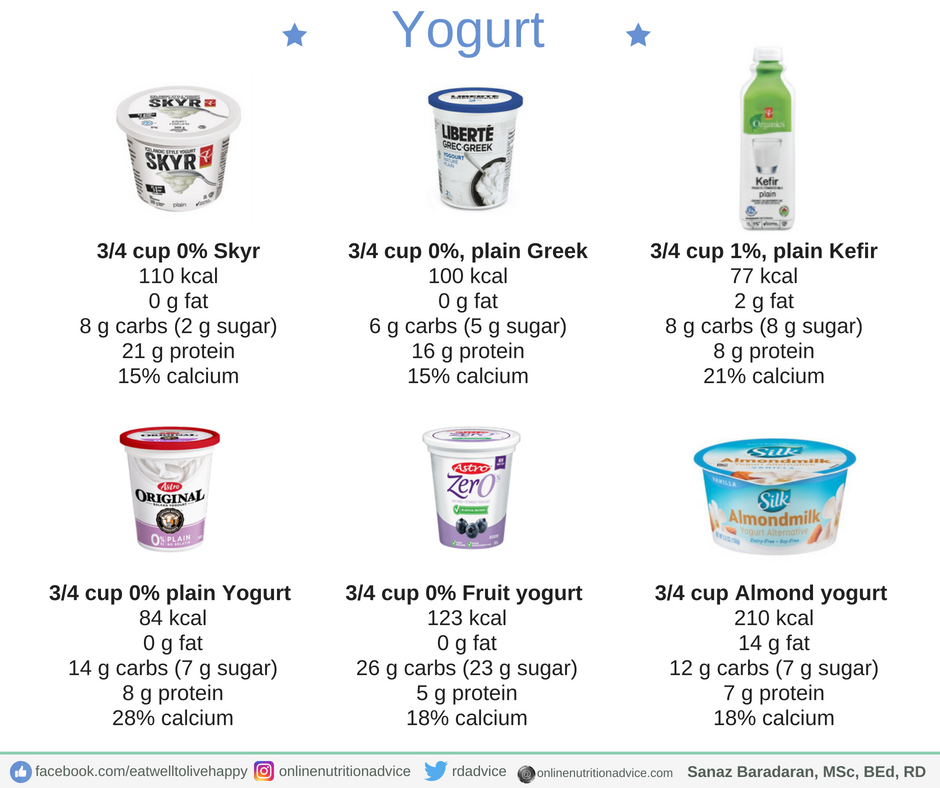A big portion of every grocery store is dedicated to the endless variety of yogurt, leaving you with many choices! This article is intended to help you choose the healthiest option based on your dietary needs.
Yogurt is a fermented product that is nutrient-dense and could be used in many different ways. Studies have linked regular intake of dairy products, including yogurt, with lower risk of diabetes and cardiovascular disease such as hypertension (1,2,3,4).
The more popular yogurt choices include:
- traditional yogurt (including plain and flavoured)
- Greek yogurt
- Skyr or Icelandic yogurt
- kefir
Recently, dairy-free yogurt products have been introduced to the market. These products are made by fermenting common milk alternatives such as soy, almond, hemp, cashew and coconut milk. Note that since dairy-free yogurt products are new to the food market, adequate research has not been conducted to observe their potential health benefits.
Regardless of your choice, the nutrients you want to look for in yogurt include:
- sugar
- protein
- fat
- calcium and vitamin D
Generally speaking, look for more protein and less sugar when choosing yogurt. When reading the nutritional information make sure you are mindful of the serving size. In addition, you may want to read the product label to see whether “live and active cultures” are present in the yogurt; this refers to the living organism present in yogurt as a result of fermentation, which promote health benefits.

Lastly, think about the purpose of purchasing yogurt. If you are using it for breakfast, you would want to choose a high protein choice, such as Greek or Skyr) to help keep you full for longer. If you are using it to make a dressing, you may choose a creamy choice. If you want to make a smoothie, kefir may provide better consistency.
The one yogurt option that is not recommended is flavoured yogurt; these choices are loaded with added sugar and have very little of the suggested nutrients, such as protein. Flavoured yogurt can be part of a healthy diet, but should be thought of as a treat rather than a healthy option to include in your regular diet. If you like flavoured yogurt consider adding fruits or a tablespoon of low-sugar jam to plain yogurt.
Bottom line: yogurt is a nutritious food that is recommended to be part of a healthy diet, particularly if it is a good source of live and active cultures.
References:
- Chen, M., Sun, Q., Giovannucci, E., Mozaffarian, D., Manson, J. E., Willett, W. C., & Hu, F. B. (2014). Dairy consumption and risk of type 2 diabetes: 3 cohorts of US adults and an updated meta-analysis. BMC medicine, 12(1), 215.
- de Goede, J., Soedamah‐Muthu, S. S., Pan, A., Gijsbers, L., & Geleijnse, J. M. (2016). Dairy consumption and risk of stroke: a systematic review and updated dose–response meta‐analysis of prospective cohort studies. Journal of the American Heart Association, 5(5), e002787.
- Gijsbers, L., Ding, E. L., Malik, V. S., de Goede, J., Geleijnse, J. M., & Soedamah-Muthu, S. S. (2016). Consumption of dairy foods and diabetes incidence: a dose-response meta-analysis of observational studies, 2. The American journal of clinical nutrition, 103(4), 1111-1124.
- Ralston, R. A., Lee, J. H., Truby, H., Palermo, C. E., & Walker, K. Z. (2012). A systematic review and meta-analysis of elevated blood pressure and consumption of dairy foods. Journal of human hypertension, 26(1), 3.